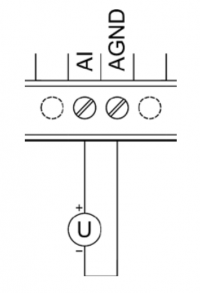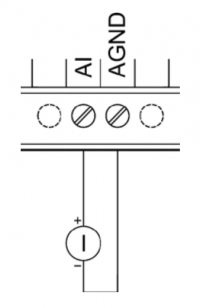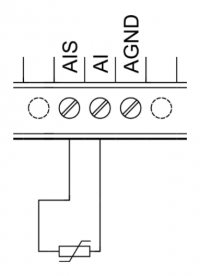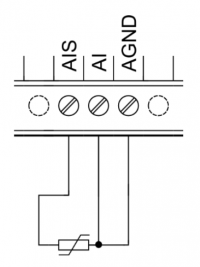Analog inputs
Measuring mode is set depending on the used software. The negative pole of the measured external device is connected to AGND terminal of the connector used, its positive pole (signal) is then connected to AIx or AIy.x terminal.
Note:
In its factory settings, the device is set to voltage measurement to prevent any potential damage of connected devices or sensors in case an unsuitable device/sensor is connected.
Caution!
Before connecting the measured device, it is necessary to check measurement settings using the chosen software and according to the type of the connected device - see the measurement description on individual sections below.
Connection
The following images illustrate the setup for measuring a voltage and current source on AI and AGND terminals. These connections are common for both section 1 and sections 2 and 3.
Resistance sensors can be connected to analog inputs using two-wire or three-wire method (available only on sections 2 and 3 except for some units, such as S5xx). The three-wire method holds the advantage of preventing measuring errors caused by the resistance of the used wire.
The information in the following note does not apply for some units such as S5xx.
Note:
Section 1 analog inputs do not support measurements of resistance sensors. This type of measurement can be performed by connecting the resistance sensor to section 1 analog output (AOR) or analog inputs of other sections.
This means S size units can be used for measuring resistance only by using analog outputs.
Description of modes
Section 1 analog inputs (with the exception of some units such as S5xx) are able to measure only voltage or current:
Measurement mode needs to be set first in the control software The expected output values are:
- Voltage → 0-10 (V⎓)
- Current → 0-20 (mA)
Analog inputs in sections 2 and 3, or on S5xx units, can measure voltage, current or resistance:
Section 2 and 3 analog inputs, or analog inputs on S5xx units, can perform accurate measurement of current, voltage or resistance. Measurement mode needs to be set first in the control software. In voltage and resistance mode you can choose from two accuracy modes. The measured value is of real type and corresponds with the measured input value (V⎓, mA, Ω).
This type of analog input supports the following modes:
- 0–10 V⎓ voltage
- 0–2.5 V⎓ voltage
- 0–20 mA current
- 0–1960 Ω resistance (three-wire)
- 0–100 kΩ resistance (two-wire)
Special functions
Aside from the standard inputs and outputs, Neuron units also feature additional functions for broadening the possible applications, performance optimization and monitoring of the entire project. These functions run directly in the I/O section's microprocessor, making them independent on the control software.
Default configuration
This function is used to save the current configuration of the section (extension module) into its memory. In the of power cycle of the device or reboot of the section (extension module), the stored configuration is loaded and applied. This functionality is also known as “copy
running-config to startup-config”.
| Stored data | Default configuration |
|---|---|
| Measurement mode | voltage measurement |
Master Watchdog
This function runs on the section's (extension module's) microprocessor and continuously monitor the commands from the application running on the unit. If no commands are detected within a configured time (MWD Timeout), the module's processor automatically reboots and reverts to the default configuration described above. This function ensures a safe configuration is set in case of emergency situations (unit failure, communication error or software issues) to prevent damage to controlled devices or any hazards to personnel.
Technical parameters
| Section 1 (AI1) | Sections 2,3 + some units (eg. S5xx) | |
|---|---|---|
| Input terminals | AI | AI, AIS |
| Common ground | AGND | AGND |
| Input modes | 0–10 V⎓ voltage meas. 0–20 mA current meas. | 0–10 V⎓ voltage meas. 0–2.5 V⎓ voltage meas. 0–20 mA current meas. 0–1960 Ω resistance meas. 0–100 kΩ resistance meas. |
| Maximum input voltage | 12 V DC | 15 V DC |
| Input resistance (voltage meas.) | 66 kΩ | 44 kΩ |
| Input resistance (current meas.) | 100 Ω | 100 Ω |
| Accuracy | ±0.5 % | ±0.2 % |
| Resolution | 12 bits | 16 bits (voltage and current meas.) 24 bits (resistance meas.) |
| Conversion time | 10 μs | 60 μs (voltage and current meas.) 400 ms (resistance meas.) |
| Protection type | Integrated overvoltage | Integrated overvoltage |
| Galvanic isolation | No | Yes (from other sections*) |



